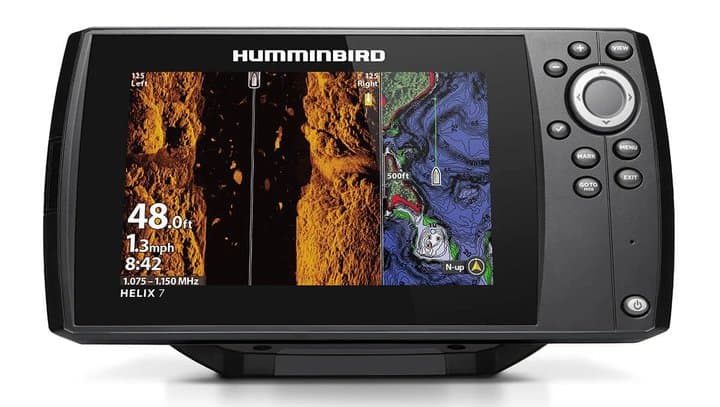The best saltwater fish finder should provide a high-resolution, sunlight-readable screen, dual or multi-frequency capabilities for various water depths, GPS and chart plotting integration for accurate navigation, CHIRP, and Imaging sonar for clearer fish arches and structure details.
We have handpicked the ideal fish finders for different saltwater environments. These include deep-sea, inshore, offshore, bay, and surf fishing areas. Our selection ensures you have the right device for your specific saltwater fishing needs.
1. Garmin GPSMAP 943XSV

Key Features:
- High-resolution Touchscreen Display
- CHIRP Sonar, SideVü, and ClearVü
- Detailed Maps
- Networking Capabilities
Garmin’s GPSMAP 943XSV is best suited for offshore and deep-sea saltwater environments. It offers advanced sonar capabilities, built-in coastal charts, and networking features. The advanced sonar can help locate schools of fish or individual game fish in deep waters, while the built-in GPS and detailed coastal charts are valuable for offshore navigation. The networking capabilities mean that it can be integrated into a larger boat system, typical of vessels used for saltwater fishing.
2. Humminbird Helix 7 Mega SI

Key Features:
- 7-inch Display
- MEGA Side Imaging and Down Imaging
- CHIRP Dual Spectrum Sonar
- Built-in GPS and Maps
The Humminbird Helix 7 Mega SI, with its MEGA Side Imaging and Down Imaging, is excellent for inshore saltwater fishing, such as flats, backwaters, and bay fishing. The detailed side and down imaging can help anglers locate fish-holding structures like reefs, drop-offs, and grass beds in shallower waters. While it’s still capable of being used offshore, its features are especially beneficial in inshore environments where detailed imaging can make a significant difference.
3. Lowrance Hook Reveal 5x Splitshot

Key Features:
- 5-inch Display
- FishReveal
- SplitShot Transducer
- GPS Plotter
- SolarMAX Display
The Lowrance Hook Reveal 5x Splitshot, with its CHIRP sonar and DownScan Imaging, is best suited for inshore saltwater fishing and nearshore environments such as bays, estuaries, and nearshore reefs. The combination of CHIRP and DownScan provides a detailed view of the underwater environment, making it easier to spot fish and structures in relatively shallow waters. The GPS plotter can help anglers mark productive fishing spots or create their own custom maps.
4. Deeper Pro+

Key Features:
- Portable Sonar
- Dual Beam Sonar
- Built-in GPS
- Wi-Fi Connectivity
- Scans depths from 2.5 ft to 260 ft.
The Deeper Pro+ fish finder is incredibly versatile due to its portability. It’s handy for shore-based saltwater anglers, such as surf fishers or those fishing from piers, jetties, and bridges. Because you can cast it out, it can scan areas that are inaccessible to boat-mounted transducers. It’s also handy for kayak or small boat anglers who may not want to install a traditional fish finder.
How to choose the best saltwater fish finder
Transducer Frequency Range
The transducer is an important component of the fish finder device that sends out and receives sonar waves. The frequency of these waves determines the detail and depth of the sonar readings.
- High Frequencies (e.g., 192kHz to 200kHz or 455kHz to 800kHz): These are best for shallower waters, typically less than 500 feet deep. They provide more detail and higher resolution images, allowing you to see individual fish and structures with clarity. This range is best for inshore or nearshore fishing like bays, estuaries, and close reefs.
- Low Frequencies (e.g., 50kHz): Best for deep-sea fishing in deeper waters (over 500 feet). They offer broader sonar beams and can penetrate deeper water layers, but with less detail compared to high frequencies. This range is best for deep-sea or offshore fishing.
Side Imaging
Side Imaging provides a nearly photographic underwater view to the sides of your boat. This feature is excellent for identifying structures, bottom contours, and fish habitats. Side Imaging sonar can be especially useful in saltwater environments with complex bottom structures, like reefs or wrecks. It’s a great feature for inshore and nearshore anglers.
GPS
A saltwater fish finder with built-in GPS allows you to pinpoint your location, create waypoints, track routes, and create custom maps. GPS fish finder is almost indispensable for saltwater fishing, especially if you’re venturing offshore. The open ocean has fewer recognizable landmarks, so GPS helps in navigation and ensures you can find your way back to shore.
Portability
Portable fish finders are designed for anglers who don’t want to permanently mount a unit on their boat. They’re also great for kayak fishing, rental boats, or ice fishing.
A fixed unit is best if you own a boat and frequently go saltwater fishing due to its robust features. However, if you’re an occasional angler or use different boats, a portable sonar is very convenient.

